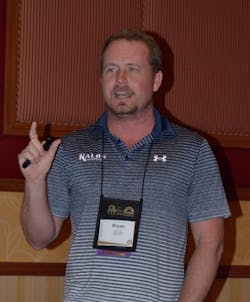It’s no secret that the construction industry — and the specialized trades such as HVACR — has had a labor shortage challenge for the last couple of decades. The rate of baby-boomer retirements far outpaces the addition of new workers, partially due to the perception of these “blue-collar” occupations.
The industry must attract 650,000 workers in addition to the “normal pace of hiring in 2022 to meet the demand for labor,” notes a February 2022 report from the Associated Builders and Contractors (ABC) (https://bit.ly/37vy4Rr).
“ABC’s 2022 workforce shortage analysis sends a message loud and clear: The construction industry desperately needs qualified, skilled craft professionals to build America,” notes Michael Bellaman, ABC president and CEO. “The Infrastructure Investment and Jobs Act passed in November and stimulus from COVID-19 relief will pump billions in new spending into our nation’s most critical infrastructure. Qualified craft professionals are essential to efficiently modernize projects across the country.”
Attracting younger people to the construction trades has been an uphill battle for the industry as it tries to compete with more “professional” occupations requiring a four-year college degree. Many parents and school counselors still regard college as the only way to a successful career — but construction professionals know differently.
The ABC report notes that ”based on historical Census Bureau Job-to-Job flow data, an estimated 1.2 million construction workers will leave their jobs to work in other industries in 2022. It is expected that this will be offset by an anticipated 1.3 million workers who will leave other industries to work in construction.”
RELATED: New Jobs Initiative Talks Directly to 'Gen Z'
“The workforce shortage is the most acute challenge facing the construction industry despite sluggish spending growth,” ABC Chief Economist Anirban Basu explains. “After accounting for inflation, construction spending has likely fallen over the past 12 months. As outlays from the infrastructure bill increase, construction spending will expand, exacerbating the chasm between supply and demand for labor.
“An added concern is the decline in the number of construction workers ages 25-54, which fell 8 percent over the past decade,” he adds. “Meanwhile, the share of older workers exiting the workforce soared. According to the Centers for Disease Control and Prevention, the industry’s average age of retirement is 61, and more than 1 in 5 construction workers are currently older than 55.”
More importantly, the construction workforce has an inadequate number of qualified, skilled workers to handle the increased amount of work, Basu says.
“More than 40 percent of construction workforce growth over the past decade is comprised of low-skilled construction laborers, who represent just 19 percent of the workforce,” he explains. “The roughly 650,000 workers needed must quickly acquire specialized skills. With many industries outside of construction also competing for increasingly scarce labor, the industry must take drastic steps to ensure future workforce demands are met.”
So, how does the HVACR field attract younger generations to manage the increased residential and commercial work that will help companies grow?
Understanding Generational Differences
Bryan Orr, co-founder and co-owner of Kalos Services (Clermont, Fla.) and founder of HVACRschool.com, spoke to HVACR contractors at the 2022 HVACR Educators and Trainers Conference, March 21-23. There he offered tips and advice on recruiting the next generation of technicians.
Understanding the different generations and what they want from a job or career is critical, he notes:
- Baby boomers, 1946-1964. This generation has a strong work ethic centered around the concept of “paying your dues.” Orr explains, “You start at the bottom and work your way to the top. ‘I did it; I pulled myself up by my bootstraps. And by golly, you should do the same.’”
- Generation X, 1965-1980. Orr notes that more Gen X women entered the U.S. workforce, and more people went to college. “College tended to have a pretty good return on investment, meaning that what you would make in your lifetime would be more than what you paid for college,” he says.
- Millennials or Generation Y, 1981-1996. For this generation, traditional education is still important; there is still value. And millennials use college as a status symbol, Orr says.
Millennials saw their parents prosper in this era, so working for a purpose became more important to them. “When you poll millennials about what they look for in their work, they'll always say purpose or impact,” he adds. “They want to see that their work matters.”
- Generation Z, 1997-2012. This generation wants to be “famous” as influencers. “Their work ethic isn't about world impact; it’s more about being seen,” Orr says. “But a lot of that is an entrepreneurial mindset, too. And they value things such as experiences; they don't value stuff.”
So, potential workers in the millennial and Gen Z generations are not “career-patient,” they don’t want to wait three or four years to get a degree or start at the bottom and work their way up.
“That type of language doesn't work for them,” Orr explains. “You're going to turn them off. You're not going to attract them. You have to think about what steps they can take quickly. How can they move from here to here, to here, to here quickly? I'm not telling you anything that hasn't been said in the past, even for millennials, but this is getting more and more extreme, more and more pronounced as we move forward.”
Appealing to Younger Workers
Pushing the concepts of less debt and less commitment is useful for potential millennial and Gen Z workers.
“We get cranky that they don't like commitment, but it's an advantage for us in the initial recruiting,” Orr notes. “What is a bigger commitment than going four years to a university to do something you don't even know if you want to do?”
Many baby boomers and older Gen Xers may see the amount of time younger generations spend on gaming sites and social media sites as a waste. Orr disagrees; many of those sites teach young people problem-solving, building and creating things, and pride of ownership, pride in their work.
“No one in this age bracket wants to work in a factory,” he says.
Orr adds that learning a trade while making money instead of raking in more debt from college is an attractive quality for Gen Z workers, who tend to be more conservative when it comes to money matters. Most likely, their parents don’t like the idea. Orr attributes much of that to peer pressure from other parents whose children may be going to expensive universities.
RELATED: Recruiting to Control Your Market
“When a parent at a party says, ‘My kid’s going to Berkeley, and he’s studying theoretical cat physics,’ and you respond, ‘Oh, my son's working as an air-conditioning technician. He went to trade school,’ that's not as sexy,” he says.
It’s a huge issue because many people don’t know what people in the trades do. Young people use social media to talk about their lives; it’s not something baby boomers or Gen Xers are comfortable doing. How do we get other generations to understand what we do in the heating and cooling trades if we don’t tell them?
Some of the benefits of working in the trades are:
- Money. Baby boomers may not have seen substantial paychecks in their trade careers, but younger trade workers see higher pay. Many in the HVACR trade can make more than someone who went for a four-year degree — with no debt.
- Reliable work. As mentioned previously, job growth in the construction trades is rapidly rising. And HVACR techs are considered essential workers — who else will fix your furnace in the dead of winter? Finally, trade jobs cannot be outsourced to another country.
- Global demand. An HVACR technician can work in any part of the world with those skills. That is very interesting to younger workers, Orr notes, especially millennials.
- Transferable skills. Much of what is learned in trade school can transfer to another industry. For example, learning to work with electricity as an electrician will also help you if you decide to go into HVACR — even if you want to be a plumber.
- Engaging work. Gen Z, in particular, has short attention spans, driven by technology, Orr says; the HVACR industry is a good fit for them. Trade workers don’t do the same thing every day; they move from job to job
- Energy efficiency and other sustainable efforts. Again, younger workers are looking to impact people’s lives. The construction industry’s green movement is an area where they can help the planet while saving people money and making them more comfortable where they live and work. “We affect the world in terms of energy and global climate change more than anyone else,” Orr notes.
What We Can Do Better
Orr explains that it doesn’t matter how we were brought up or how we learned the trade; it matters how the industry — educators and company management, will work to make younger workers successful in the HVACR trade.
It doesn’t matter how we were brought up or how we learned the trade; it matters how the industry — educators and company management, will work to make younger workers successful in the HVACR trade.
“We get math-y in our trade sometimes,” he says. “We get excited as educators about math. I think sometimes that's a mistake. Math is good, but think about what we're trying to accomplish with math. We're using math to solve problems, to teach them the relationships between things. However, sometimes we make people think that this industry is not for them because we immediately hit them with a bunch of math.”
The calculations are not the most important thing; it’s learning the meaning behind them. “Let people who love science, love science, be good at science and be good technicians without hassling them so much about the math,” Orr notes.
'Sometimes we make people think that this industry is not for them because we immediately hit them with a bunch of math.' - Bryan Orr
And avoid creating false expectations to attract poor candidates. “They may be extremely intelligent, kinesthetic learners, hands-on, visual, but you get them in an environment where there's going to be a lot of stuff thrown at them, they become very nervous — and those nerves lead to bad results,” he says.
The industry needs to illustrate the different opportunities within the trades — something Orr says it does not do well. Young people can have a lucrative and rewarding career in the HVACR trade, and there are different paths they can take.
Orr notes that more emphasis should be placed on rewarding creativity rather than punishing weaknesses.
To help HVACR technicians stay successful, Orr notes that more emphasis should be placed on rewarding creativity rather than punishing weaknesses. “There are a thousand different ways to do everything in the real world,” he says. “So, creativity, being willing to make mistakes, and learning from your mistakes is actually how the world works.”
Recruiting plan focus: 1. Mental health days or flex time. 2. Be specific about pay scale. 3. Paint a clear picture of what you do.
When you make up your recruiting plan, Orr says to focus on these things: be mindful of the focus on mental health and offer mental health days or a flexible time off schedule; be specific about health-care benefits and your pay scale; describe an HVACR career as a parallel path to a college-degreed occupation, and compare the benefits; make sure the company website gives a clear picture of what you do and how you do it, and has photos posted of your staff and blog posts about company activities; and bring in tradespeople or industry influencers to talk about the trade to school groups, community events, etc.
RELATED: RECRUITING FOR YOUR HOME SERVICES COMPANY
“The No. 1 key to get better at recruiting, training and hiring any generation is to stop whining about it and do it,” Orr notes. “Stop complaining; it doesn't help. With the younger generations, be appreciative of what they do know and teach them the stuff they don't.”
Kelly Faloon is a contributing writer to Contractor magazine and principal of Faloon Editorial Services. The former editor of Plumbing & Mechanical magazine, she has more than 30 years of experience in B2B publishing, with 20 of those years writing about the plumbing, heating, cooling and piping industry. Faloon is a journalism graduate of Michigan State University. You can reach her at [email protected].
About the Author

Kelly L. Faloon
Freelance Writer/Editor
Kelly L. Faloon is a contributing editor and writer to Contracting Business magazine, Contractor and HPAC Engineering. The former editor of Plumbing & Mechanical magazine, Faloon has more than 20 years experience in the plumbing and heating industry. She started a freelance writing and editing business in 2017, where she has a varied clientele.
Faloon spent 3 1/2 years at Supply House Times before joining the Plumbing & Mechanical staff in 2001. Previously, she spent nearly 10 years at CCH/Wolters Kluwer, a publishing firm specializing in business and tax law, where she wore many hats — proofreader, writer/editor for a daily tax publication, and Internal Revenue Code editor.
A native of Michigan’s northern Lower Peninsula, Faloon is a journalism graduate of Michigan State University. You can reach her at [email protected].

